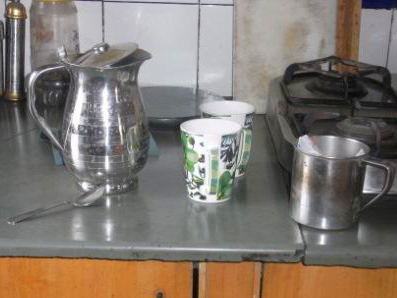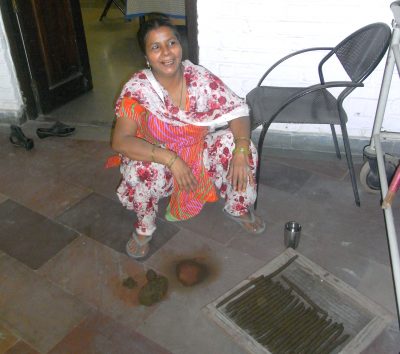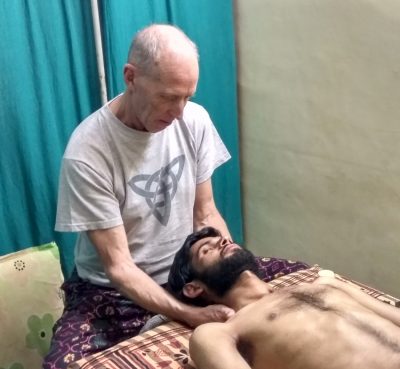
2017 in Bhopal
Spineworks is a form of physical therapy which focuses on the body’s soft tissue. It understands the body as a structure in tension where the bones act as spacers, anchors, and levers, while the muscles bind it together- as opposed to the idea of our soft tissue hanging on a compressed skeleton.
In treatment, Spineworks focuses on the soft tissue – muscles, tendons, and fascia to address what we may call non-specific pain. Skeletal alignment, including of the spine, is performed without using force as, once tension in soft tissue is released, the space is there for the structure (skeleton) to find its own way back into alignment. If it doesn’t, then encouragement is offered with (for example) gentle vibration and muscle energy techniques.
Ian Jarvis is the tutor for all Spineworks courses and has been practicing Spineworks since 1994 after training with the founder Tarpan Williams on his first courses in the UK. In 2011, Ian travelled to Bhopal offering his help to the Sambhavna Trust Clinic and, in the years since, Ian has become a great friend of Bhopal volunteering in both India and the UK, and raising funds through public speaking and book sales. Now, in 2017 he is on his fourth extended stay as a volunteer at the clinic. In Ian’s words:
“What is it like as a volunteer at the Sambhavna Trust Clinic in Bhopal? As I write this, at just after six on a Sunday morning about two months after arriving here, I sit at my laptop in the semi-darkness of my room because the power went off just as I got up. But don’t worry, you don’t have to be up at six! That is a personal choice – unless you work in the garden, because, at the moment and in the summer, the gardeners, Ratna, Mukesh and Manmohan begin work at about five as it gets too hot by mid-day so they finish then for the day. And of course, they don’t do that on Sunday!
“But we do work a 6-day week here and that makes a difference to us who are used to a 5-day week. I’m not writing these things to put you off but if you do plan to come here for research or volunteering you need to be realistic in your expectations.
“I first came here in 2011 when I was looking for something more ‘interesting’ and began what has become a long-term relationship as I am now on my fourth visit. Many of the staff are still here as for many it’s more than a job, more of a calling, but there are also some new faces. Shweta is the new yoga teacher, a naturopathic doctor so she also talks to people about nutrition which is a real problem here and there are a lot of overweight people. One of the doctors, Dr Qaiser, left and then returned so it was really nice to meet him again. There is also a new doctor, Dr Sattivan, who I am just getting to know, and there are several other new faces around, including security guardians.
“Going back to my opening paragraph, we do ‘suffer’ with many power cuts. During the week there can be several during the day, mostly of relatively short duration and covered by the solar circuit and the generator. But on many Sundays, it can go off in the morning and remain off until the afternoon. It is so regular that I rather think the power company may schedule maintenance at the power station for this time. Sometimes though it is for our own maintenance; the electrician has become quite a friend recently! It does have the benefit of getting us off our computers though – which I will have to do soon as the battery is getting low.
“I will just add that there is a good internet access here now so you can keep in touch with family and friends with such modern accoutrements as Skype and WhatsApp! (Unless there is a power cut!)

“I have also been fortunate to meet up with some old volunteer colleagues. Devendra was here on my second visit in 2013, and has been here since! He’s originally from the deserts of Rajasthan but is now almost a Bhopali. He has a major new task, with sponsorship from one of the five campaign organisations (so he’s no longer a volunteer), which he is now in the middle of, in digitising the entire library. There are many books and documents, including newspaper cuttings, that comprise the library and it has reached the stage where it needs something of an overhaul as well as preserving in electronic form.
“Shortly after I arrived we had a visit for a few days from Harshit another from India itself, whom I met also on my 2013/14 visit. Harshit is a photographer and is now driving a project with the tribal people of Gondwana, a large geographic area which the Government seems to want to give to mining and other companies. So there are several projects involved including building some community centres.
“Yesterday, Umesh, from Boston, USA but with relatives near here in Indore, came for a day during his family visit to India. Since meeting here we have kept an occasional electronic contact.
“I just missed Thorsten as he left a day before I arrived, but it was getting a bit hot for a Swede. The Swede who WAS here though was Ingrid, a doctor originally involved in one of the early studies and who wrote an excellent and detailed book about the disaster itself.
“You may have spotted that (apart from Ingrid) they are all male, including me, but there are also female volunteers that come and several I’ve met along the way, Linda (with husband Peter), Melanie (now working with the BMA in UK), Danielle (with partner Fabien) an Italian-French couple who were on a world-trip and are now back in Turin, Heidi an Austrian from the mountains, ??? from the Czech Republic who is now running a school in Benares/Varanassi, plus several others and, right now, Karuna from Brazil who is trained in Ayuveda and wanted to learn some of the practicalities so she can advance her practice when she returns home.
“All together, taken over time, the volunteers are a mixed bunch. On occasions when the cook didn’t come I can recall one or two very mixed menus as everyone gathered in the kitchen to offer one of their local dishes.

“What type of work is there for a volunteer? You are asked before coming here to think about what you might offer and discuss it with Sathyu but sometimes it doesn’t work out anyway. Help is ALWAYS needed and welcomed in the garden! The work is hot and tiring and can be a bit grubby as well but since the garden feeds the manufacturing unit it is a crucial part of Sambhavna. (Stick some gloves and tools in your baggage.) Sometimes there is work in the library if there is a project on – anything from writing or drawing to computer work. Currently and maybe for another year, Deven would welcome assistance with scanning of documents.
“It is not necessarily all about work though. Several people have come to do research, Bruno, Heidi, Paul and Roy leap to mind. Sathyu has long said that it is as much about what you take away with you as what you bring. You will learn so much whether you are here primarily to work or for research, that you will be able to speak more cogently about the disaster and, importantly, it’s lasting affects than ever you could just by making a donation. You just never know where it will lead, possibly to a new major ssupporter.
“One thing I now do after my first visit is talk about corporate social responsibility with Bhopal as the prime example and using my practical experience of working here (Sambhavna) and in Chingari.
“You never know where a spot of volunteering will lead!”


